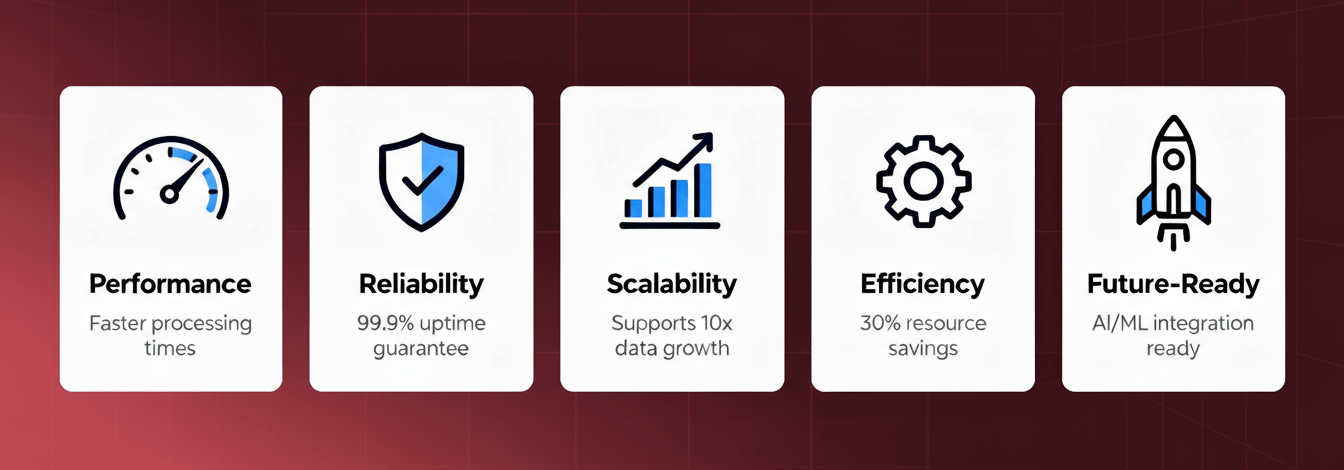
Modernizing Loan Approval with InspectDate: How Upgrading to Rails 8 Unlocked Speed, Scalability, and Simplicity
Table of Contents
ToggleInspectDate helps financial institutions approve loans by connecting them with reliable vendors who handle property inspections and verifications. As the platform grew, the team realized it needed to strengthen its technology base to keep up with rising customer expectations, ensure smooth scalability, and simplify ongoing maintenance. This became a critical part of their broader fintech modernization strategy.
The modernization project involved three key upgrades:
- Ruby upgraded from version 2.5.1 to 3.3.3
- Rails upgraded from version 6 to 8.0.1 — a major Rails upgrade initiative
- Docker introduced for consistent deployments and environment stability
This initiative was a strategic Rails upgrade solution designed to ensure the platform remains fast, secure, and adaptable to future needs.
Challenges Before the Upgrade
Before modernization, InspectDate’s system architecture had started showing its age. The frontend relied on older build setups that slowed down performance, made it hard to manage new dependencies, and created friction for the development team.
Some of the challenges included:
- Slow and outdated build processes that made feature updates time-consuming
- Complicated dependency management that increased maintenance effort
- Limited compatibility with newer frameworks and libraries
- Performance inefficiencies that impacted page load times and user experience
- Inconsistent development environments that made debugging more complex
These issues made it difficult to sustain high performance and quick releases as the product continued to expand—especially for a platform focused on loan approval automation.
The Modernization Approach
The InspectDate team took a structured approach using professional Rails migration services to bring the platform in line with modern standards.
1. Upgrading Rails and Ruby: The latest versions provided significant performance improvements, better memory handling, and built-in support for modern development tools. This Rails upgrade formed the backbone of the modernization project.
2. Adopting Modern JavaScript Bundling: The upgrade replaced the legacy build process with a new, faster setup powered by ESBuild. This brought more stability, easier integration with modern libraries, and reduced build times.
3. Containerized Deployment with Docker: Docker ensured consistent environments across development, testing, and production—an essential component of scalable Rails upgrade solutions.
Together, these upgrades created a more unified, predictable, and efficient technology ecosystem—critical for long-term fintech modernization.
The Migration: From Webpacker to esbuild
Here’s how we transitioned:
bundle remove webpacker
bundle add jsbundling-rails
rails javascript:install:esbuildWe restructured our asset pipeline, rewired build scripts, and removed legacy Webpack configs for a clean, blazing-fast setup that supports future-ready loan approval automation workflows.
Our Detailed Minimal esbuild Setup
We kept things lean with a simple package.json configuration:
{
"scripts": {
"build": "esbuild app/javascript/application.js --bundle --sourcemap --format=esm --outdir=app/assets/builds",
"watch": "esbuild app/javascript/application.js --bundle --sourcemap --format=esm --outdir=app/assets/builds --watch",
"copy:assets": "cp -r app/assets/images/* public/images/"
}
}Notes and tips:
--bundle combines all JS files into a single output, avoiding multiple requests.
--sourcemap Keeps debugging easy in browsers.
--format=esm allows modern ES modules, making code cleaner.
--watch enables automatic rebuilds when files change.
copy:assets ensures images and static files are available without a complex loader.Results and Technical Outcomes
The modernization delivered strong improvements supporting both business and product goals, reflecting the power of well-executed Rails migration services:
- A unified build process that integrates seamlessly with the latest Rails ecosystem
- Modern JavaScript support, allowing for clean, modular code and faster front-end performance
- Streamlined dependency management with simpler workflows for developers
- Optimized builds that reduced page load times and improved caching efficiency
- Faster rebuild times during development, which improved team productivity
- Consistent deployment environments that reduced errors and improved uptime
These improvements created a stronger foundation for future innovation while enhancing overall system performance.
Improved Developer Experience
The modernization also transformed how developers work within the InspectDate ecosystem.
- The setup process became simpler and faster
- The architecture encouraged clean, modular, and maintainable code
- Debugging became more straightforward with clearer workflows
- Frontend and backend processes now work in perfect sync
- Modern tools like React or Vue can now be integrated easily
This aligns with long-term fintech modernization goals where developer speed and reliability directly impact product evolution.
Business Benefits and Impact
Beyond the technical success, the upgrade delivered meaningful business results.

1. Faster Platform Performance
Optimized code and streamlined processes have made the platform more responsive. Loan approvals, data exchanges, and dashboard interactions now happen more smoothly, creating a better experience for both lenders and vendors.
2. Stronger Reliability and Security
By eliminating outdated components, the platform became more secure and stable. The introduction of Docker added consistency to every deployment, ensuring that every environment behaves predictably.
3. Easier Maintenance and Scalability
The new structure makes it much simpler to introduce updates, manage dependencies, and scale as demand increases. The platform can now support a growing vendor network without slowdowns or operational friction.
4. Higher Development Efficiency
Faster build times and cleaner workflows have led to a measurable improvement in team productivity. Developers can now focus on innovation, new features, and user experience instead of troubleshooting setup issues.
5. Future-Ready Foundation
InspectDate’s architecture is now aligned with modern standards, which means future updates and integrations can happen quickly and smoothly. This positions the platform for long-term sustainability and faster evolution.
Conclusion: Building for the Future
The modernization of InspectDate was more than a tech upgrade—it was a strategic investment in fintech modernization, future growth, and product stability.
By embracing the latest versions of Rails and Ruby, streamlining the frontend with modern build tools, and standardizing deployments through Docker, the team built a platform that is faster, easier to manage, and ready to scale.
This initiative has led to improved customer experiences, reduced maintenance overhead, and a stronger development culture focused on innovation rather than firefighting.
InspectDate now stands on a modern, efficient, and secure foundation—one that empowers the business to move faster, serve customers better, and stay future-ready in a rapidly evolving digital landscape.
Looking to upgrade your platform to Rails 8 or modernize your fintech product?
Talk to our expert team for end-to-end Rails migration services and future-ready Rails upgrade solutions.Let’s build your next breakthrough together.
For a deeper technical breakdown of the Rails 6 to Rails 8 migration and how ESBuild helped resolve JavaScript performance bottlenecks, check out Dharmik Salakiya’s detailed article on Medium:
Migrating from Rails 6 to 8: How ESBuild Helped Us Fix the JavaScript Bottleneck





